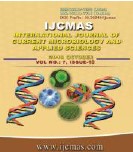


 National Academy of Agricultural Sciences (NAAS)
National Academy of Agricultural Sciences (NAAS)

|
PRINT ISSN : 2319-7692
Online ISSN : 2319-7706 Issues : 12 per year Publisher : Excellent Publishers Email : editorijcmas@gmail.com / submit@ijcmas.com Editor-in-chief: Dr.M.Prakash Index Copernicus ICV 2018: 95.39 NAAS RATING 2020: 5.38 |
Plantation sector plays an important role in export to meet the domestic requirement and in employment generation and poverty alleviation, particularly in rural areas. The total production of tea in India is 1,208,780 tonnes. Assam is the single largest tea growing state accounting for half of the country’s total production. India is the second largest producer and fourth largest exporter of tea in the world. The world total export quantity of tea is 1,829,550 tonnes. The total consumption of tea in India has gradually increased from 2013-14 (911,000 tonnes) to 2015-16 (951,000 tonnes).The paper attempts to quantify the changing structure of Indian tea exports. Data for analysis was taken for a period of 30 years from 1985 to 2015. Compound growth rate (CAGR) was used for analysing the growth in tea area, production, yield, export quantity and export value over the years. The study revealed that the growth rate the area, production and yield, export quantity, export value of tea showed 1.5 per cent, 2.2 per cent, 0.6 per cent, 1 per cent, 2 per cent respectively in study period. EPR was used to estimate the comparative advantage of the commodity. The Export Performance Ratio (EPR) initial value of tea was 21.25 and finally reached 3.84 in 2015.which revealed that tea EPR value was decreased more than seven times in the overall period.
 |
 |
 |
 |
 |